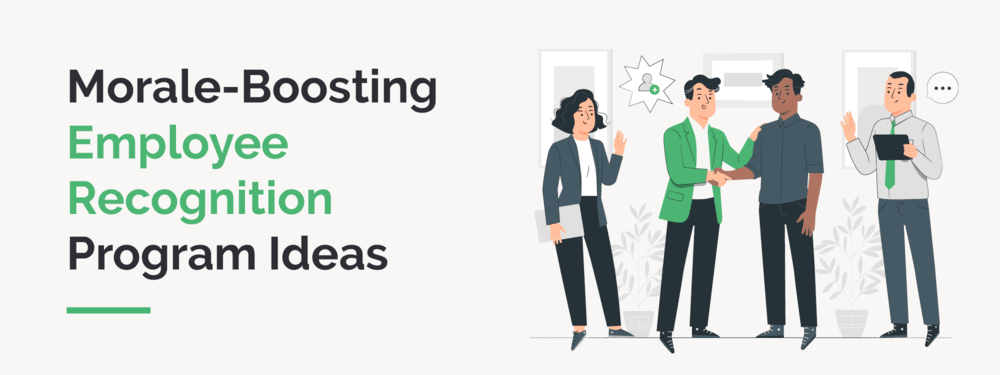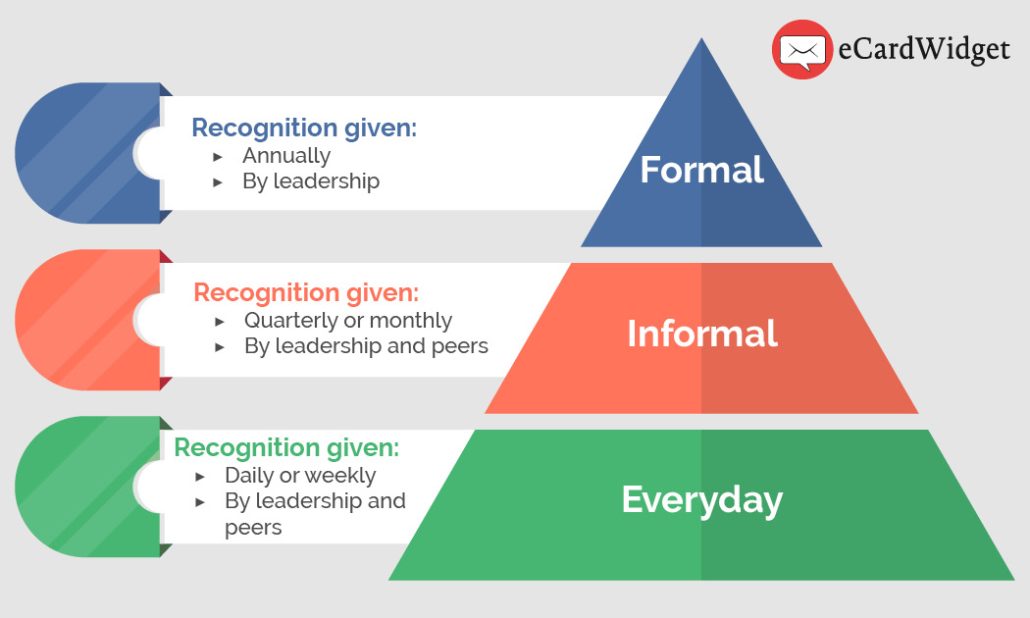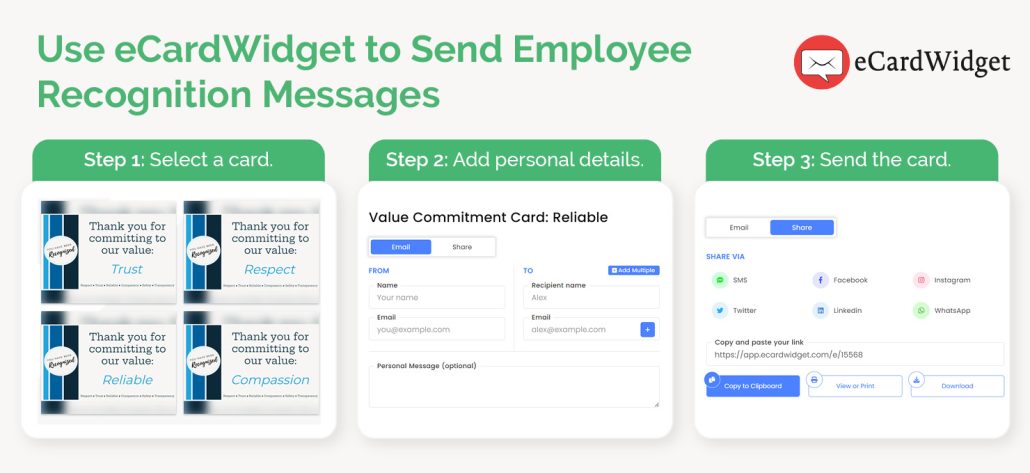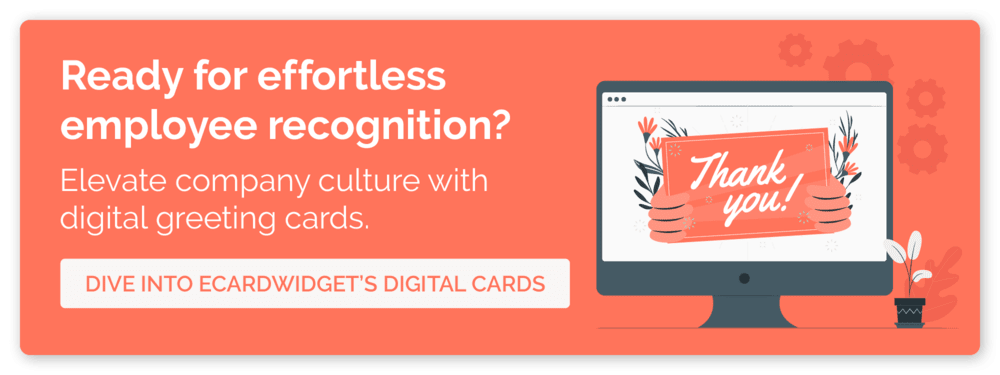Morale-Boosting Employee Recognition Program Ideas
Let’s say you’re an upper-level manager at a corporate office. You walk into the office that morning, enjoying the positive and productive atmosphere. Employees seem very motivated, are very responsive to communications, and are energized and engaged during one-on-one meetings. You even receive an email from an important client about how satisfied they are with one of your sales representative’s work.
By the end of the day, you’re pleasantly surprised by the changes but start to wonder what sparked them. After speaking with one of your directs, you find that they’ve introduced a few small employee recognition tactics to motivate employees like sending eCards in response to a job well done. As a result, employees are more aware of your company’s gratitude for their hard work, feel more connected to their teams, and are motivated to do their best while at work.
While this is a great start, your business can see even more long-term benefits by creating a structured, office-wide employee recognition program. In this guide, we’ll explore how your company can improve or start its own recognition program as well as a few ideas:
- Why is employee recognition important?
- How can you start an employee recognition program?
- What are the best employee recognition program ideas?
Employee recognition programs can support and improve your company culture. When your workplace has a strong sense of community, you’ll see increased retention, more participation in workplace giving programs, higher satisfaction, and a more positive reputation.
Why is employee recognition important?
According to eCard Widget’s guide to employee engagement, “Employee recognition is the practice of acknowledging or rewarding employees for their contributions to your organization.” Often, this is shown through employee recognition programs, which are systems used to reward employees’ work.
These programs can have many benefits for your business. Structured employee recognition programs can:
- Increase engagement and retention. When employees’ work and accomplishments are acknowledged and positively reinforced, they’ll feel more motivated to continue putting in effort at work. In turn, employees will feel more productive, satisfied, and fulfilled, yielding higher retention rates over time.
- Improve teamwork. By encouraging employees via recognition and urging them to recognize their peers’ accomplishments, your business can boost team morale and strengthen bonds between coworkers. Acknowledging one another’s hard work cultivates a sense of camaraderie and teamwork, encouraging valuable collaboration among team members.
- Cultivate a more positive company culture. The above items can all contribute to a stronger sense of community and culture at work. Employees value and thrive in positive work environments, and this can translate into higher-quality work that your clients notice. In fact, studies show companies with a strong culture are 89% more likely to report high levels of customer satisfaction.
Although employee recognition is important, it can be difficult to implement at times. Smaller organizations may find that a lack of available staff time is a barrier that prevents them from even beginning the process of implementing an employee recognition program. Fortunately, there are ways to mitigate these issues and create a robust program that motivates employees to continue excelling.
For example, if you’re planning on giving gifts to your employees as part of your program, you could consider working with a corporate gifting company. These companies reduce the time and stress associated with gift-giving by offering curated gift selections that you can personalize. Plus, they’ll handle sending the gift straight to your employee, so you won’t have to worry about delivery yourself.
To truly take advantage of the benefits of employee recognition (many of which can only be seen in the long term), you’ll need to design a sustainable program that works for your organization. If needed, test different approaches or start small and work up to a more involved approach. You can make improvements along the way, and your team won’t get burned out organizing high-effort, extravagant recognition events.
How can you start an employee recognition program?
There is no “one size fits all” employee recognition program. Designing your program starts with selecting the appreciation tactics and recognition software that best align with your workplace and employee preferences. There are two key considerations to keep in mind when choosing recognition tactics: how recognition is delivered and who delivers it.
Here are the two types of recognition that impact how the feedback is delivered:
- Informal recognition. This is not an “organized” form of recognition and isn’t typically planned in advance. It tends to be more small scale. Informal recognition may come in the form of giving a shout-out during your company-wide meetings or sending a peer an eCard to thank them for spending some extra time on an important project.
- Formal recognition. This type of recognition is usually more structured, on a larger scale, and planned ahead of time. This is the most traditional type of employee recognition, often provided in the form of a bonus, raise, or positive performance review. Think of formal recognition as the foundation for all of your other recognition efforts to sit on top of.
There are also differences in who recognizes employees’ work:
- Leader-to-direct recognition. Here, feedback is given to a direct from a leader. So, a manager might tell an employee that they appreciate them working hard to complete an urgent, unplanned project by its deadline to please a client.
- Peer recognition. This recognition is given by an employee to a fellow peer. For example, one member of your sales team could shout out a fellow sales representative for giving them advice during a tricky client scenario.
Reference these basic types of recognition to ensure you have the right mix of recognition types in your program. According to the employee recognition pyramid, formal recognition should occur annually, informal should occur monthly or quarterly, and “every day” or very casual recognition should occur daily or weekly.
Aside from considering the type of recognition you’d like to give to your employees, you’ll want to plan out your program to ensure that it runs as smoothly as possible. This ensures that your employees feel appreciated, as you don’t want their experience to be marred by poor planning.
Important details to include in your recognition program’s plan include:
- Budget
- Frequency
- Recognition eligibility and criteria
- Selection process
- Rewards
Additionally, if you need external help for your employee recognition program, you should outline that in your plan. For example, if you plan to create an employee appreciation wall, you’ll want to determine which business you’d like to handle creating the plaques and how much it will cost.
What are the best employee recognition program ideas?
While the traditional way to recognize employees is to offer raises and bonuses, this is only the beginning of a comprehensive recognition program. Since these compensation changes typically only occur one to two times a year, it’s important to recognize all of the progress and accomplishments your employees have made between performance reviews.
Here are eight employee recognition program ideas for your business to try (along with real-world examples for each idea!):
1. Employee Gifts
Giving employees tangible gifts in return for their dedication and hard work is a great way to recognize them for both their day-to-day and larger-scale achievements. Because you can give them almost anything, this idea can be adapted to fit many different scenarios just by changing the value of the gift. For example, your business might purchase a $15 gift card to a coffee shop for someone’s birthday but offer them a $100 coffee machine if they close a big sale.
When giving employee gifts, make sure to consider what your employees will truly appreciate. Choose gifts that fall at the appropriate value and tailor them to your industry. For example, if you work in an office, you might give employees blue light glasses or a self-warming coffee mug. On the other hand, if you run a lawn care business, consider giving them insulated water bottles or hats.
Top Employee Gift Examples
- Gift cards to local restaurants
- Tickets to a movie, museum, or other experiential activity
- Company-branded merchandise
- Donation to a nonprofit organization on the employee’s behalf
2. Milestone Celebrations
Acknowledge and celebrate important employee milestones to show that you are following their progress and value their commitment to your organization. There are many milestones in employees’ lives that your business can celebrate. You might choose:
- Professional milestones like 10 years at the company or a promotion
- Personal milestones like birthdays or an upcoming wedding
Celebrate these milestones in a way that matches the significance of the occasion and the employees’ preferences. While you might have an extravagant lunch for an extroverted employee who is retiring after 20 years, some employees might prefer a private email with a gift instead.
Top Milestone Celebration Examples
- Significant “workiversaries”
- Promotions or role changes
- Retirement, particularly after many years at the company
- Personal milestones like birthdays, weddings, or baby announcements
3. Recognition Awards
These awards are given to reward your employees for work-related achievements. Offering recognition awards can boost employees’ confidence and productivity, motivating them to keep up the good work.
So, what opportunities does your business have to recognize employees with these awards? Reward those who go above and beyond in their role or show that they work exceedingly well with others on their team. Additionally, your company can recognize and reward employees who receive positive feedback from their clients. To encourage them to be self-sufficient and take initiative, give awards to those who lead new projects or have innovative ideas.
Top Recognition Award Examples
- Certifications (e.g., the employee earns a certificate for completing a training course)
- Plaques or trophies for formal, large-scale accomplishments
- A free meal or coffee
- Additional time off or the option to work remotely
4. Thank-You Notes
These notes are a simple way to send quick, informal feedback to employees. If a manager notices that an employee completed all of their tasks for the day ahead of schedule, they might send them an email thanking them for it.
Rather than a plain, short email, consider using eCards to send thank-you messages. These electronic cards are great for both in-person and remote employees, and they offer a more personalized touch. You can brand them to your company and include custom images and text. And because they can be sent from anyone to anyone, they’re suited to both peer recognition and recognition from leaders.
eCardWidget is a great tool you can use to celebrate your team’s wins. With eCardWidget, you can create shareable eCards in just a few steps:
- Select a card to send. Choose from the range of eCards for various occasions. The card might thank an employee for committing to a specific company value, wish them a happy birthday, or welcome them to the company.
- Fill in personal details. Add your name and email address, as well as the recipient’s contact information. Then, fill in a personal message. Make sure to be specific, name the exact achievement or action you want to recognize. Rather than saying, “Thank you for being responsive!” write a message like, “Thank you for responding so quickly to my email about my issue with a client. It helped me resolve the problem in no time.”
- Send the message. Once your message is complete, send the email immediately or schedule it to be delivered later. You can also share the eCard via SMS, LinkedIn, and other social media platforms.
Top Thank-You Note Examples
- eCards
- Handwritten cards or letters
- Emails
- Group appreciation cards (i.e., everyone on your team signs a card)
5. Employee Recognition Spotlights
Regularly acknowledge employees’ contributions publicly. Highlight their dedication, skills, or a particular idea they had to improve the business. You can also recognize any recent initiatives they pushed forward and explain how that initiative bettered the business.
To share their achievements with the rest of the business, consider featuring them in your newsletter or on the company’s website or social media page. You might interview the employee to learn more about how they worked toward the accomplishment (which can double as an educational guide for other team members).
If your company doesn’t use communication channels like newsletters or social media, consider giving them the spotlight during a company meeting. Then, recognize their efforts and ask them to walk through the process to set an example for other team members.
Top Employee Recognition Spotlight Examples
- Post about the employee on social media or your website
- Choose and highlight a specific employee of the month/quarter
- Highlight an entire team
- Recognize innovative ideas each week
6. Wellness Rewards
While this idea is similar to giving employees gifts, it focuses on wellness specifically. Show employees you value and support their well-being by gifting them goods and services that will improve their physical and mental health. These items could be anything from a one-month gym membership voucher to a weighted blanket to a book about work-life balance.
Not only do these gifts show that your business wants to make an investment in their health, but they can have major positive impacts on the company. Recognition-led wellness programs can protect employees from burnout which harms productivity, retention, and even your bottom line. With these programs in place, studies show that employees are up to 90% less likely to report feeling burned out on a regular basis.
Top Wellness Reward Examples
- Gift cards for a massage or spa treatment
- Wellness-related products (e.g., teas, essential oils, or yoga equipment)
- A subscription to a meditation or fitness app
- Gym membership voucher
7. Peer Recognition
Robust, frequent peer recognition is a great way to bring teams together, reinforce positive self-image, and develop employees’ sense of confidence in their roles.
It’s best to acknowledge a peer’s work immediately, helping to ensure that their accomplishments don’t fall through the cracks. To support this, make sure to share guidelines with your team about how to participate in this part of the recognition program and make delivering positive feedback easy and approachable.
eCards are a great tool to use for this idea because they are convenient and easy to use. When you launch this idea, make sure to send out instructions on how to use eCards. To incorporate public recognition into this idea, create a physical or virtual kudos board where employees can post about an achievement their peer had for the rest of the company to view.
Top Peer Recognition Examples
- Notes, eCards, or emails to peers
- Kudos boards
- Recognition during meetings
- Small gifts or treats
8. Employee Appreciation Events
Take the time to celebrate everything your employees do for the business. You might host an office party or organize a catered lunch after the entire office reaches your quarterly goal.
Keep employee-related holidays in mind, too. National Employee Appreciation Day, which falls on the first Friday of March, is a great opportunity to organize a free meal or office celebration for everyone. Additionally, check for holidays that are specific to your industry. For example, a tech company might celebrate National IT Professionals Day in September, and a school would observe Teacher Appreciation Week in May.
Top Employee Appreciation Event Examples
- Organize a company potluck or catering for the office
- Send gift baskets to remote employees
- Offer gift cards or vouchers
- Rent out a bowling alley or arcade for a fun night out
9. Employee Engagement Software
One of the best ways to streamline your employee recognition efforts is through designated software. By standardizing the program processes you’ve put in place, you’ll ensure that none of your staff members feel left out or forgotten. Plus, you’ll establish a fair system for rewarding their efforts.
Some of the top engagement software options your company can use include:
- eCardWidget: We’ve already discussed the importance of digital cards, but this is the best tool for sending messages to your employees. Plus, you can create templates and send eCards for any occasion, not just as a thank-you message. Sending a card for employees’ birthdays, for example, will help them feel appreciated.
- Qualtrics: If you’re ever wondering what your employees think about the company or their jobs, Qualtrics is the best tool for finding out! Send feedback surveys, and use the software’s analytics tools to measure your employees’ satisfaction (and make any necessary changes to your work environment!).
- Cloverleaf: Learning and development is a great way to incentivize employee retention, but can also help your employees feel recognized for their potential. Invest in your employees through Cloverleaf’s automated coaching programs.
Once you’ve selected the tool that will most improve your employee recognition efforts, be sure to train team members on how to use it. Incorporate the software into your office policy handbook, clearly laying out how employees can access necessary tools, such as feedback surveys or workshops.
Additional Resources
With diligent, dedicated effort toward employee recognition, your business can build a program that makes employees feel acknowledged and valued at your organization. The best way to encourage regular recognition is to make giving positive feedback and shoutouts easy for peers or managers to do—ideally on a weekly or daily basis.
eCardWidget supports employee recognition programs by streamlining the process. Book a demo to learn how to get these uplifting, personalized messages in your employees’ inboxes.
If you’re looking for more about improving employee engagement and building a supportive corporate culture, check out these resources:
- Employee Engagement Software: Crash Course & 10+ Top Options. Looking for tools to help you engage your employees? Check out this guide to using employment engagement software.
- A Full Guide to Employee Engagement Tools + 20 Top Picks. Support your search for the perfect employee engagement tool with this list of the top 20 software providers.
- Top Corporate Giving Software to Drive Employee Engagement. Corporate giving initiatives are the perfect complement to employee recognition programs. Learn about the top software providers to support workplace giving at your company.






